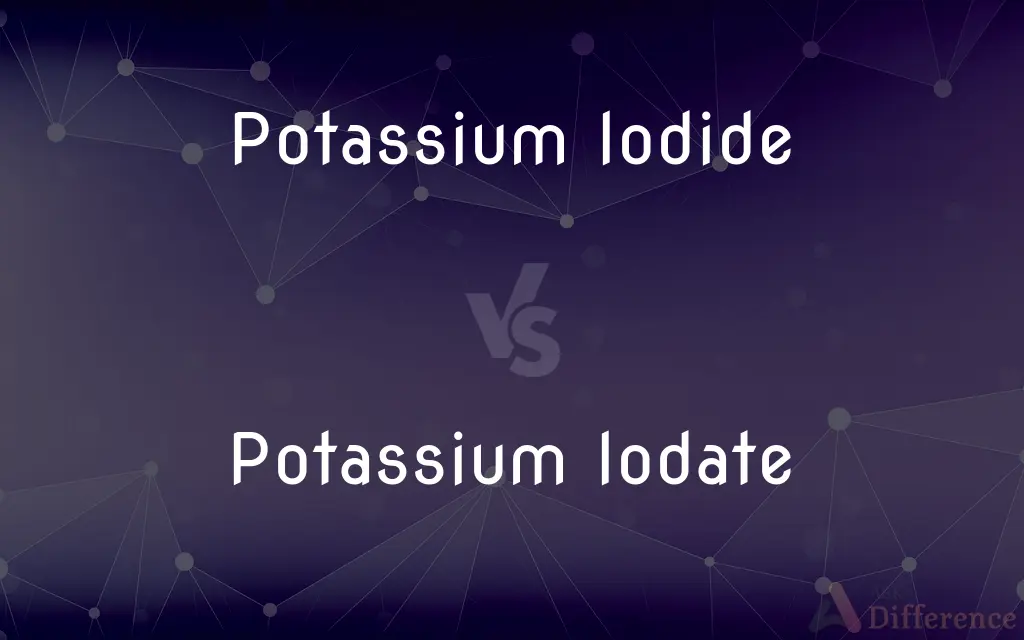Potassium Iodide vs. Potassium Iodate — What's the Difference?
By Tayyaba Rehman — Published on November 14, 2023
Potassium Iodide (KI) is an inorganic compound used in medicine and radiation protection, while Potassium Iodate (KIO₃) is a compound used as an iodine supplement in salt and for thyroid blocking in radiation emergencies.

Difference Between Potassium Iodide and Potassium Iodate
Table of Contents
ADVERTISEMENT
Key Differences
Both Potassium Iodide and Potassium Iodate serve vital roles in health and safety. Potassium Iodide (KI) is a well-known inorganic compound, white in appearance, and often used in the medical field. It can be used as a dietary supplement, but it's perhaps most recognized for its use as a protective agent against radiation, where it helps prevent radioactive iodine from accumulating in the thyroid gland.
On the other hand, Potassium Iodate (KIO₃) is another compound that shares similarities with Potassium Iodide but has a distinct chemical structure and set of applications. Like KI, Potassium Iodate can be used as an iodine supplement, especially in iodized salt. This is crucial in regions where iodine deficiency is prevalent. Additionally, Potassium Iodate is used as a thyroid blocking agent in radiation emergencies, similar to KI.
While both Potassium Iodide and Potassium Iodate can offer protection against radioactive iodine, their mechanisms differ slightly. When ingested, KI provides the thyroid with sufficient iodine, reducing the uptake of radioactive variants. Potassium Iodate functions similarly but has an advantage in certain situations due to its ability to offer longer-lasting protection.
In terms of chemistry, Potassium Iodide is a salt that forms when hydroiodic acid reacts with potassium hydroxide. Potassium Iodate, conversely, results from the reaction of iodine with potassium hydroxide, followed by oxidation.
While both compounds are beneficial, it's essential to use them under proper guidance, especially in emergency scenarios. Overconsumption of either can lead to iodine-related complications. It's always recommended to follow guidelines and seek expert advice when considering their use.
ADVERTISEMENT
Comparison Chart
Chemical Formula
KI
KIO₃
Primary Use
Radiation protection & dietary supplement
Iodine supplement in salt & radiation protection
Origin
Reaction of hydroiodic acid with potassium hydroxide
Reaction of iodine with potassium hydroxide, followed by oxidation
Protection Mechanism
Saturates thyroid with iodine
Offers longer-lasting thyroid protection
Physical Appearance
White crystalline solid
White crystalline solid
Compare with Definitions
Potassium Iodide
Utilized for radiation protection.
In the event of a nuclear incident, Potassium Iodide can be administered to protect the thyroid gland.
Potassium Iodate
Has a longer protective duration compared to KI.
In radiation emergencies, Potassium Iodate might be preferred due to its extended protective window.
Potassium Iodide
A white, crystalline inorganic compound.
Potassium Iodide is commonly used in table salt to prevent iodine deficiency.
Potassium Iodate
Offers protection against radioactive iodine.
Potassium Iodate can be given to individuals exposed to nuclear radiation as a protective measure.
Potassium Iodide
Can prevent radioactive iodine uptake.
Potassium Iodide offers protection by ensuring the thyroid does not absorb radioactive iodine.
Potassium Iodate
An iodine-rich inorganic compound.
To combat iodine deficiencies, some countries add Potassium Iodate to table salt.
Potassium Iodide
Formed from hydroiodic acid and potassium hydroxide.
When hydroiodic acid reacts with potassium hydroxide, the result is Potassium Iodide.
Potassium Iodate
Derived from iodine and potassium hydroxide.
Potassium Iodate is produced when iodine reacts with potassium hydroxide and undergoes oxidation.
Potassium Iodide
An essential component in some medications.
Certain expectorant drugs contain Potassium Iodide to help break down mucus.
Potassium Iodate
Often used as a salt additive.
To ensure populations receive adequate iodine, Potassium Iodate is sometimes added to salt products.
Common Curiosities
Can both Potassium Iodide and Potassium Iodate be used for radiation protection?
Yes, both can offer protection against radioactive iodine by saturating the thyroid, but they function slightly differently.
What is the chemical difference between Potassium Iodide and Potassium Iodate?
Potassium Iodide has the formula KI, while Potassium Iodate has the formula KIO₃.
How does Potassium Iodate assist in addressing iodine deficiencies?
Potassium Iodate is added to table salt in some regions to provide a dietary source of iodine and prevent deficiencies.
Are there any side effects associated with excessive intake of Potassium Iodide or Potassium Iodate?
Yes, excessive intake can lead to iodism, which may present as metallic taste, sore mouth, or other symptoms.
Which compound is more commonly found in iodized table salt?
While both can be used, Potassium Iodate is more commonly added to table salt as an iodine supplement.
How are Potassium Iodide and Potassium Iodate produced chemically?
Potassium Iodide is produced by reacting hydroiodic acid with potassium hydroxide, while Potassium Iodate results from iodine's reaction with potassium hydroxide, followed by oxidation.
Can both compounds be used for medical imaging?
While Potassium Iodide can be used in some radiological imaging due to its iodine content, Potassium Iodate is generally not used for this purpose.
Which one, between Potassium Iodide and Potassium Iodate, offers longer protection against radiation?
Potassium Iodate is believed to provide longer-lasting thyroid protection compared to Potassium Iodide.
What is the primary use of Potassium Iodide in health?
Potassium Iodide is primarily used for thyroid protection against radiation and as an iodine supplement.
In the event of a nuclear accident, which compound is recommended for thyroid protection?
Both can be used, but the availability and specific guidelines will depend on regional health authorities.
Are there any dietary sources rich in Potassium Iodide or Potassium Iodate?
Iodized table salt can contain either compound, but natural dietary sources of iodine, like seaweed, usually have iodine in other forms.
Are Potassium Iodide and Potassium Iodate safe for all age groups in the event of radiation exposure?
Both can be used across age groups, but dosages and guidelines might differ for infants, children, adults, and pregnant or breastfeeding women.
Do Potassium Iodide and Potassium Iodate have uses outside of health and nutrition?
Yes, besides health applications, they are used in various chemical reactions and processes in the chemical industry.
Is Potassium Iodate considered more stable than Potassium Iodide for long-term storage?
Yes, Potassium Iodate is generally more stable and less hygroscopic than Potassium Iodide, making it more suitable for prolonged storage.
How do Potassium Iodide and Potassium Iodate work in preventing radioactive iodine uptake?
They saturate the thyroid with non-radioactive iodine, reducing the amount of radioactive iodine that the thyroid can absorb.
Share Your Discovery

Previous Comparison
Taiwanese Food vs. Chinese Food
Next Comparison
Cloud Computing vs. Distributed ComputingAuthor Spotlight
Written by
Tayyaba RehmanTayyaba Rehman is a distinguished writer, currently serving as a primary contributor to askdifference.com. As a researcher in semantics and etymology, Tayyaba's passion for the complexity of languages and their distinctions has found a perfect home on the platform. Tayyaba delves into the intricacies of language, distinguishing between commonly confused words and phrases, thereby providing clarity for readers worldwide.














































